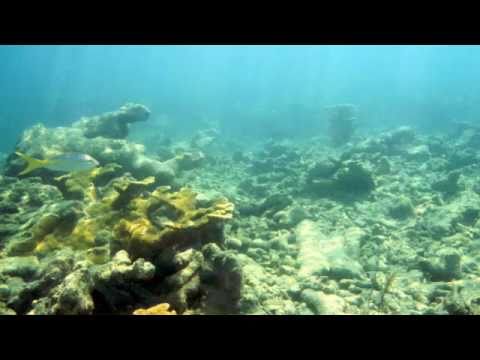NOAA, I Would Ask For Your Money Back on those Radars
There has been an almost continual decline in coral cover in the Florida Keys in all habitats since 1996, with a mean decrease from 11.9% cover in 1996 to 6.7% in 2005. The hard-bottom habitat usually has a low cover of isolated, small coral colonies alongside gorgonians (octocorals), sponges and other organisms; but this habitat makes up the largest proportion of rocky substrata within the Sanctuary. These data have been collected at multiple stations with 43 fixed sites along the Florida Keys, by the Florida Keys National Marine Sanctuary, US Environmental Protection Agency and NOAA since 1996, via the Coral Reef Evaluation and Monitoring Project (CREMP), which also involves the Florida Fish and Wildlife Research Institute and the University of Georgia. The top figure shows a precipitous decline in bleaching years with a leveling-off of coral cover since the 1997-98 bleaching events and the hurricanes of 1998, 2004 and 2005. The lower graph shows the same precipitous decline in all coral habitat types between 1996 and following the 1997-98 bleaching
events and subsequent coral disease outbreaks. Coral cover is higher in the patch reef areas compared with offshore reefs. The patch reefs have been exposed to broader ranges of sea surface temperatures, sediments and nutrients over a much longer timeframe i.e. centuries compared with decades (data from http://www.floridamarine.org).
NEXRAD Inventory: Choose Day and Product
Period of Record:Level-II: 07/20/1996 to 06/09/2014
Level-III: 07/24/1996 to 06/06/2014
| Specifications | |
|---|---|
| frequency: | 2,700 – 3,000 Megahertzes |
| pulse repetition time (PRT): | |
| pulse repetition frequency (PRF): | 320…450, …1300 Hz |
| pulsewidth (τ): | 1.57 and 4.57 µs |
| receive time: | |
| Gain (dBi): | 45.5 |
| peak pulsed power: | 750,000 Watts |
| peak pulsed power density @ 10 km | 21.2 W/m2 or 2120 µW/cm2 |
| displayed range: | 460 km |
| range resolution: | 47 m or 135 m |
| beamwidth: | 0,96° (2,7GHz) to 0,88° (3 GHz) |
| display levels: | 15 |
| antenna rotation: | 3 rpm |
Unexpectedly, a strong non-thermal character of biological effects of Radio Frequency Radiation has been documented. As low as 0.1 µW/cm2 intensity of RFR
Key West Reefs Dying Of Mysterious Disease
DIVING offshore south of here recently, Craig Quirolo was shocked to find much of the coral a sickly white, smothered by a mysterious, creeping disease that was choking the life from reefs more than 5,000 years old.
”They’re sick and they’re dying,” said Mr. Quirolo, who founded the Reef Relief conservation group. ”When the coral reefs go, the fisheries go, and there goes our food chain.”
The newly discovered affliction, named white pox by marine biologists, comes after several other ailments have consumed coral ecosystems around the world, a situation most often linked to pollution and other intrusions by people.
But the white pox is so new that scientists do not yet know what causes it, let alone how to stop it. If it spreads unchecked, the scientists fear, the entire shallow-water marine ecosystem of the Florida Keys could be thrown off balance.
Question: What do you get when you take a military weapon, the pulsed microwave radar and use it for civilian purposes such as airport surveillance and weather?
ANSWER: LOTS OF DISEASED AND DEAD STUFF!
Bad, Bad, Bad, Bad, Bad, Bad, Bad, Bad, Bad, Bad, Bad, Bad, Bad, Bad,Bad, Bad, Bad, Bad, Bad, Bad, Bad, Bad, Bad, Bad, Bad, Bad, Bad, Bad,Bad, Bad, Bad, Bad, Bad, Bad, Bad, Bad, Bad, Bad, Bad, Bad, Bad, Bad,Bad, Bad, Bad, Bad, Bad, Bad, Bad, Bad, Bad, Bad, Bad, Bad, Bad, Bad,Bad, Bad, Bad, Bad, Bad, Bad, Bad, Bad, Bad, Bad, Bad, Bad, Bad, Bad,Bad, Bad, Bad, Bad, Bad, Bad, Bad, Bad, Bad, Bad, Bad, Bad, Bad, Bad,Bad, Bad, Bad, Bad, Bad, Bad, Bad, Bad, Bad, Bad, Bad, Bad, Bad, Bad,Bad, Bad, Bad, Bad, Bad, Bad, Bad, Bad, Bad, Bad, Bad, Bad, Bad, Bad,Bad, Bad, Bad, Bad, Bad, Bad, Bad, Bad, Bad, Bad, Bad, Bad, Bad, Bad,Bad, Bad, Bad, Bad, Bad, Bad, Bad, Bad, Bad, Bad, Bad, Bad, Bad, Bad,Bad, Bad, Bad, Bad, Bad, Bad, Bad, Bad, Bad, Bad, Bad, Bad, Bad,





